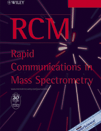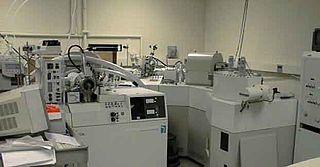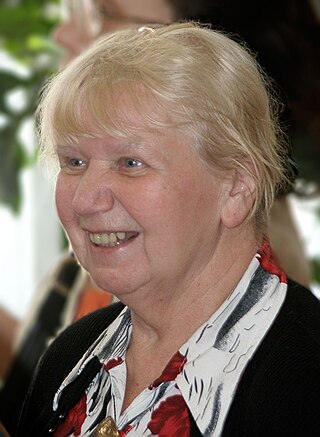Related Research Articles
The thomson is a unit that has appeared infrequently in scientific literature relating to the field of mass spectrometry as a unit of mass-to-charge ratio. The unit was proposed by Cooks and Rockwood naming it in honour of J. J. Thomson who measured the mass-to-charge ratio of electrons and ions.

The history of mass spectrometry has its roots in physical and chemical studies regarding the nature of matter. The study of gas discharges in the mid 19th century led to the discovery of anode and cathode rays, which turned out to be positive ions and electrons. Improved capabilities in the separation of these positive ions enabled the discovery of stable isotopes of the elements. The first such discovery was with the element neon, which was shown by mass spectrometry to have at least two stable isotopes: 20Ne and 22Ne. Mass spectrometers were used in the Manhattan Project for the separation of isotopes of uranium necessary to create the atomic bomb.

Rapid Communications in Mass Spectrometry (RCM) is a biweekly peer-reviewed scientific journal published since 1987 by John Wiley & Sons. It covers research on all aspects of mass spectrometry. According to the Journal Citation Reports, the journal has a 2020 impact factor of 2.419.
Robert Graham Cooks is the Henry Bohn Hass Distinguished Professor of Chemistry in the Aston Laboratories for Mass Spectrometry at Purdue University. He is an ISI Highly Cited Chemist, with over 1,000 publications and an H-index of 144.
Keith Robert Jennings is a British chemist known for his contributions to mass spectrometry.

Mass-analyzed ion kinetic-energy spectrometry (MIKES) is a mass spectrometry technique by which mass spectra are obtained from a sector instrument that incorporates at least one magnetic sector plus one electric sector in reverse geometry. The accelerating voltage V, and the magnetic field B, are set to select the precursor ions of a particular m/z. The precursor ions then dissociate or react in an electric field-free region between the two sectors. The ratio of the kinetic energy to charge of the product ions are analyzed by scanning the electric sector field E. The width of the product ion spectrum peaks is related to the kinetic energy release distribution for the dissociation process.

Ambient ionization is a form of ionization in which ions are formed in an ion source outside the mass spectrometer without sample preparation or separation. Ions can be formed by extraction into charged electrospray droplets, thermally desorbed and ionized by chemical ionization, or laser desorbed or ablated and post-ionized before they enter the mass spectrometer.

Michael (Mickey) Barber, FRS was a British chemist and mass spectrometrist, best known for his invention of fast atom bombardment ionisation.
The British Mass Spectrometry Society is a registered charity founded in 1964 that encourages participation in every aspect of mass spectrometry. It aims to encourage participation in all aspects of mass spectrometry on the widest basis, to promote knowledge and advancement in the field and to provide a forum for the exchange of views and information. It is committed to ensuring equal opportunities and reflecting the diversity of the society as a whole. The first foundations of the BMSS were laid in 1949 with the establishment of the Mass Spectrometry Panel by the Hydrocarbon Research Group.

John H. Beynon FRS was a Welsh chemist and physicist known for his work in mass spectrometry.
In mass spectrometry, a matrix is a compound that promotes the formation of ions. Matrix compounds are used in matrix-assisted laser desorption/ionization (MALDI), matrix-assisted ionization (MAI), and fast atom bombardment (FAB).
Richard Evershed is a Professor of Biogeochemistry and Fellow of the Royal Society.
A. Gareth Brenton FLSW. is a Welsh physicist and chemist known for his work in mass spectrometry.

Ron M.A. Heeren is a Dutch scientist in mass spectrometry imaging. He is currently a distinguished professor at Maastricht University and the scientific director of the Multimodal Molecular Imaging Institute (M4I), where he heads the division of Imaging Mass Spectrometry.
David Edgar Games was a Welsh chemist best known for his work in mass spectrometry and chromatography.
Swansea University has had a long established history of development and innovation in mass spectrometry and chromatography.
John J. Monaghan is a British mass spectrometrist and former editor of Rapid Communications in Mass Spectrometry.

Lidia Nikolaevna Gall was a Russian mass spectrometrist, credited as one of the inventors for electrospray ionization source and high-performance mass analyzers.
Brian Noel Green OBE was an English mass spectrometrist. He had a long career at Metropolitan-Vickers before moving to VG MICROMASS in 1972.
References
- 1 2 "Aston Medal". British Mass Spectrometry Society. Retrieved 13 January 2015.
- ↑ "BMSS: 17th Annual Meeting". Rapid Communications in Mass Spectrometry. 3 (11): 411–412. 1989. Bibcode:1989RCMS....3..411.. doi:10.1002/rcm.1290031110.
- ↑ Games, D. E. (1990). "British Mass Spectrometry Society Aston Medal Awarded to Professor J. H. Beynon FRS". Rapid Communications in Mass Spectrometry. 4 (11): 491. Bibcode:1990RCMS....4..491G. doi:10.1002/rcm.1290041109.
- ↑ Mallet, Tony (1996). "British Mass Spectrometry Society: Aston Medal Award to Brian Green". Rapid Communications in Mass Spectrometry. 10 (12): 1566. doi: 10.1002/(sici)1097-0231(199609)10:12<1566::aid-rcm1011>3.0.co;2-f .
- ↑ "Aston Medal 1998 - Keith Jennings" (PDF). British Mass Spectrometry Society. Archived from the original (PDF) on 4 March 2016. Retrieved 13 January 2015.
- ↑ "Aston Medal 1999 – Dai Games" (PDF). British Mass Spectrometry Society. Retrieved 13 January 2015.[ permanent dead link ]
- ↑ "Aston Medal 2013 – Colin Pillinger" (PDF). British Mass Spectrometry Society. Archived from the original (PDF) on 12 February 2017. Retrieved 13 January 2015.
- ↑ "Aston Medal 2005 – Tom Preston" (PDF). British Mass Spectrometry Society. Archived from the original (PDF) on 4 March 2016. Retrieved 13 January 2015.
- ↑ "Aston Medal 2006 – John Todd" (PDF). British Mass Spectrometry Society. Archived from the original (PDF) on 4 March 2016. Retrieved 13 January 2015.
- ↑ "Aston Medal 2008 – Robert Bateman MBE" (PDF). British Mass Spectrometry Society. Archived from the original (PDF) on 4 March 2016. Retrieved 13 January 2015.
- ↑ "Aston Medal 2010 – Richard Evershed" (PDF). British Mass Spectrometry Society. Retrieved 13 January 2015.[ permanent dead link ]
- ↑ "Professor Awarded Aston Medal". The University of Nottingham. Retrieved 13 January 2015.